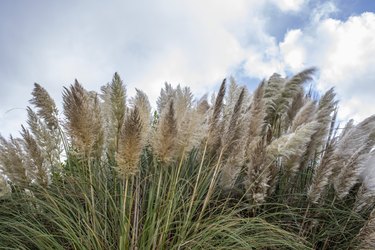
Tall and distinctive, pampas grass (Cortaderia selloana) makes a showy statement in the landscape as a perennial in U.S. Department of Agriculture plant hardiness zones 7 through 10. Sometimes it's almost too showy — the non-native plant is categorized as invasive in many areas, including parts of California. To keep this large plant under control, cut back pampas grass all the way to the ground at least once a year.
Tip
Cut back pampas grass in late winter, when the plant is dormant and before new growth appears in early spring.
Video of the Day
When to Cut Back Pampas Grass
The best time to cut back pampas grass is in late winter, before new growth appears. While it grows as a perennial throughout its hardiness range, it is not evergreen in freezing climates. Still, many cultivars are cold-hardy and can survive in climates colder than USDA zone 7, especially with winter protection.
Video of the Day
When cold weather sets in, the foliage and stems turn brown, dry out and die. They also become a fire hazard. Make room for new growth by cutting it back almost to the ground.
Methods of Cutting Pampas Grass
Pruning this plant is not a simple matter. At maturity, pampas grass can reach a maximum average height and spread of 10 feet. Because of the size of pampas grass, an electric chainsaw, power hedge trimmers or lopping shears are most effective in cutting back the plants.
Sterilize power tools by wiping or spraying the blades with rubbing alcohol. You can dip the blades of hand tools in rubbing alcohol or a household cleaner such as Lysol or Pine-Sol. Allow your tools to air dry before you start cutting. This will help prevent the spread of fungal and bacterial diseases.
Protect yourself as well — even dry, pampas grass leaves have sharp edges, and they will slice easily through your skin if you aren't careful. Wear safety goggles, long sleeves, long pants, closed-toe shoes and elbow-length gloves when cutting back the plant.
Combing Out Dead Foliage
Pampas grass is a vigorous grower and can grow from its roots to its maximum height — or close to it — in one season, so cutting it back to the ground won't really limit its size. If you don't have the tools to cut it all the way down, remove the dead foliage from the plant by combing it.
Take a small garden rake and use it to grab and pull the dead foliage from the plant. Any dead leaves will easily pull away from the main plant. This will help clean up the appearance of the pampas grass without having to cut it all the way back.
Cutting the Plumes for Decoration
Pampas grass is best known for its tall, feathery plumes. The striking plumes are often used in dried flower arrangements. If you'd like to harvest the prunes, use lopping shears to clip them off right after they fully open. If you wait too long, they will start shedding, especially in heavy rains or winds.
Hang the plumes upside down in a dark, dry location for one to two weeks. Spray with an acrylic fixative or hair spray to ensure that the seeds stay on the plant, instead of scattering across your table and tablecloth.